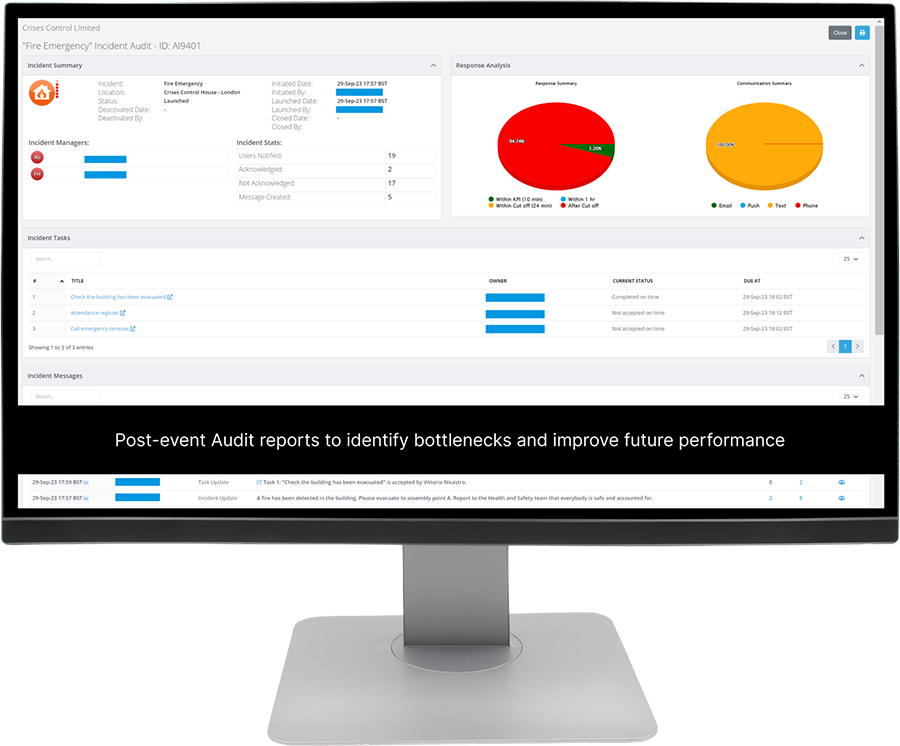IT Alerting, Simplify Incidents in an Emergency

How can you expedite IT Alerting during a crisis?
IT Services often have associated Service Level Agreements (SLAs) which have financial implications if breached. An unplanned outage at a data centre can cost over £5,000 a minute. The quicker responders and stakeholders receive critical alerts, the quicker they can begin to respond to the incident, and get things up and running again.
When a crisis incident starts, every second counts Crises Control can make sure your response teams receive an alert on their Phone, SMS, and App no matter where they are in the world.
Crises Control can:
- Simplify incident alert information from your monitoring and issue tracking tools into meaningful, actionable notifications and tasks.
- Engage the required people, gain situational perspective and trigger resolution steps directly from notifications.
- Give auditable visibility of how incidents were responded to help your teams make improvements for next time.
How Crises Control helps in an Incident
Get information out to the IT response team faster
When a crisis hits, and an emergency alert is released, Crises Control will automatically alert all responders through multiple channels until they acknowledge receipt.
As responders acknowledge the alert, they are added to a virtual ‘war room’, and connected to the virtual command and control centre. One click, and all responders can be called into a conference call.
Faster incident resolution
In the heat of a crisis, everyone needs to know what their tasks are without thinking. While paper or server based plans may set out those tasks, they may not be available during a crisis.
The Crises Control Incident Plan Builder and Task Manager bring incident management into the Crises Control platform, enabling workflows, task assignments, time based escalation settings, and other digital assets to be disseminated to responders quickly, so that everyone knows their roles. The Task Manager tracks every task, and records responses for improvement activity.
Keep stakeholders informed
Control the narrative, and ensure that the right messages are released to such stakeholders as employees, decision makers and managers, legal and compliance officers and bodies, and even the public.
With Crises Control’s platform you can ensure that the right information is released to each group.
Gain performance insights
Every message, alert, task, decision, and response during a crisis is recorded so that you can analyse performance for improvements, or gather proof for compliance and post even analysis sessions.
Take control of IT Alerting in a crisis with Crises Control
- Plan your incident and management and resolution tasks
- Create step by step remediation tasks and workflows for IT teams
- Distribute tasks to IT teams based on availability, roles, and locations
- Bring everyone into one ‘room’ with conference calls
- Record all communications during the incident for post event analysis
- Use captured data to review the response, and improve it for next time

FAQs
Most organisations have some form of network operations system, even if it's rudimentary, that utilises ticketing and monitoring systems to keep track of server and critical network device health. However, the issue lies in the fact that IT crises can occur at any time, and research has shown that engaging the response team can often take hours, especially when multiple parties need to be involved in resolving the crisis.
Overall, alerting responders during IT incidents enables swift action, collaboration, and effective incident management, helping to minimize disruptions, uphold service levels, and improve the overall incident response capabilities.
Alerting delays can lead to breaches in Service Level Agreements, resulting in reputational damage and potential compensation claims.
Moreover, during a crisis, engaging the client and informing users often becomes a secondary priority. The response team is often burdened with additional time-consuming distractions, such as frustrated users calling to complain about the unavailability of services, further impeding their ability to address the crisis effectively.
Crises control can provide that communication layer to reduce the time to engage the right people and communicate with the other parties including the users. Overall, alerting responders during IT incidents enables swift action, collaboration, and effective incident management, helping organisations minimize disruptions, uphold service levels, and improve their overall incident response capabilities.
Alerting responders in the event of IT incidents serves several important use cases. Here are some common scenarios where alerting responders is crucial:
- Rapid incident response: Network & IOT Devices and critical Applications
- Rapid deployment of message desk disseminating information to users.
- Escalation and collaboration: Alerts facilitate involving necessary teams and individuals to work together for incident resolution.
- Prioritising incidents: Alerts help responders prioritise based on severity, impact, and predefined priorities.
- SLA adherence: Prompt alerts support meeting response time commitments and avoiding penalties.
- Tracking incident status: Alerts enable efficient monitoring and communication about incident progress.
- Continuous improvement: Incident alerts aid in post-incident analysis for identifying patterns and areas for improvement.
Yes, Crises Control's IT alerting software is highly customisable and can be tailored to meet the unique needs of your organisation. This includes creating custom workflows, setting up automatic notifications, and integrating with other systems and tools.
Yes, the IT alerting software can be used to communicate with employees during a crisis event, such as a major IT outage. This can help keep everyone informed and minimise disruption to business operations.
Crises Control's IT alerting software can help manage a wide range of IT-related crises, including system outages, security breaches, software bugs, and hardware failures.
Yes, Crises Control's IT alerting software is designed to integrate seamlessly with other systems and tools, including IT service management (ITSM) tools, monitoring platforms, and communication platforms.
Yes, Crises Control's IT alerting software includes advanced reporting and analytics features that allow you to track the effectiveness of your alerting processes and identify areas for improvement.
Crises Control offers comprehensive training and support to ensure that your team is equipped to use the IT alerting software effectively. This includes initial training sessions, ongoing support, and access to a dedicated support team.
Crises Control takes security very seriously and uses advanced encryption and security protocols to ensure that your data is protected. The system is also regularly audited and tested to ensure compliance with industry standards.
Faster critical IT alerting with Crises Control
Critical IT alerting is key for every organisation to stay on top of unfolding events in an emergency. Crises Control simplifies incident alert information from your monitoring and issue tracking tools into meaningful, actionable notifications and tasks. Engage the required people, gain situational perspective, and trigger your crisis resolution activity directly from the initial notification.
Service Desk Task Tracking
Use the Task Manager to allocate tasks to IT support and other teams, track progress to completion, or escalate when needed. Use the auditing function to review events later.
Critical Incident Management
In the event of a critical incident, use the Crises Control platform to keep response teams and other stakeholders informed and track task progress until the issue is resolved.
Integration with other Tools
Improve incident response mechanisms by integrating the Crises Control platform with various systems such as ticketing systems, server monitoring tools, antivirus software and Internet of Things (IoT) devices. This allows for seamless communication and collaboration among response teams, as well as the ability to monitor and respond to incidents in real-time.